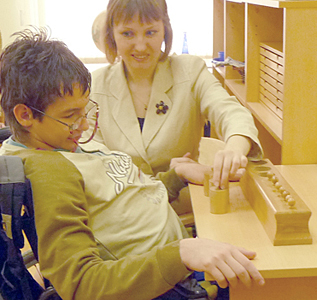CONCENTRATION
|
||
|---|---|---|
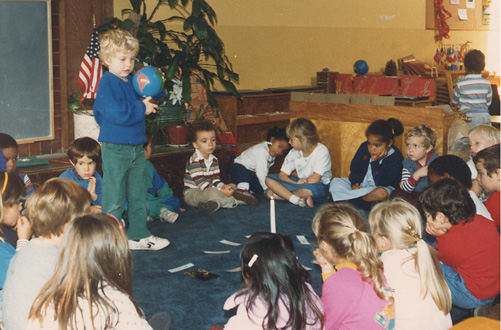 Forward to friends |
||
As I was scanning this picture of a Montessori 3-6 birthday party celebration and looking at it on the computer screen I could see for the first time the look of complete boredom on the faces of the children who had been pulled away from concentrating on their individual work to "celebrate." I did the math: 30 children x 3 years in the class = 90 birthdays! This brought home to me the reason why there are no "required" group or collective lessons, no regular "circle" time, in authentic Montessori classes. |
||
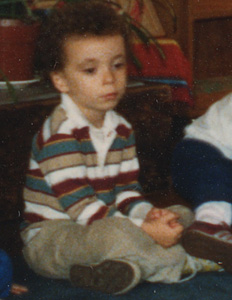 |
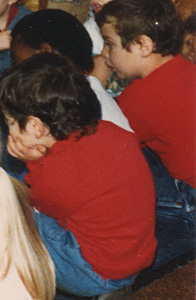 |
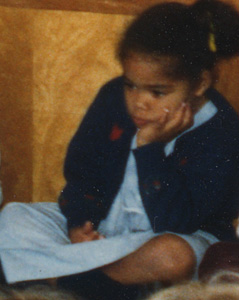 |
Seeing this birthday celebration was an eye-opener for me as a Montessori consultant and course examiner. It is not part of any AMI Montessori teacher training course, rather an example of many practices that make their way into the classroom when the teacher does not understand the implications. For example, the relationship between the earth and the sun is one of the first "great lessons" in the elementary, age 6-12 class, when the minds of children are such that they can reach back into time and far into space. But before this age, during the sensorial period of life, all concepts must be real and understandable through the senses in the here and not. Giving information too early, or at the wrong stage of development, is confusing, and harmful in too many ways to go into here. When work and concentration on activities appropriate for the child's stage of development are protected the potential for optimum development is seen in ways previously not thought possible. A human being is revealed who knows that happiness does not come from things or fame, who exhibits a love of silence, a natural impulse to do good work, to learn, and to help others. This is the magic of Montessori. |
||
The greatest sign of success for a teacher is to be able to say, This means children are so busy concentrating they don't notice where the teacher is! To help a teacher change from the traditional collective lessons, to the Montessori 1:1 lessons and protection of concentration, Dr. Montessori developed the following observation tool. It tracks the developing concentration ability of a child over the period of 3 hours each morning. This 3-hour work period is free of any scheduled activities such as "circle time", group outside play, group snack, specialist teacher giving lessons, etc. More on these work curves or graphs can be found in The Advanced Montessori Method, Volume I. |
||
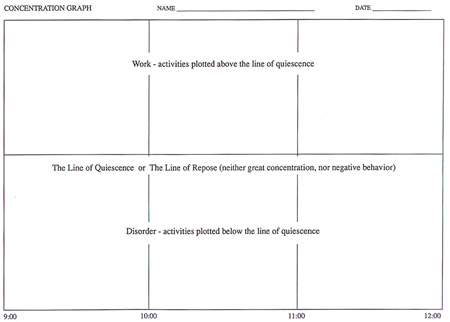 |
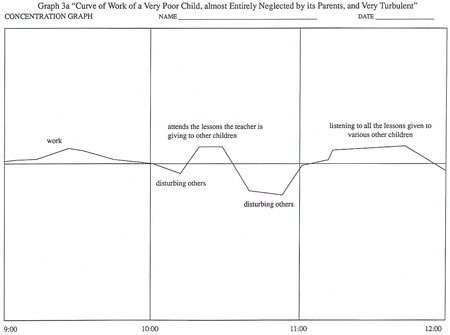 |
||
| This is the description of the "work curve" (sometimes called "concentration graph"). The middle line is neutral, above the line is work/order/concentration, below the line is disorder/disruption. The actual graph used by the teacher would be blank except for the time at the bottom, the name of the child and date. | All of these graphs are taken from Dr. Montessori's book "The Advanced Montessori Method, Vol. I". It is normal in a child who is just beginning to attend the Montessori class to exhibit disturbing behavior, to interrupt others who are concentrating, and to be unable to focus on anything for long. | ||
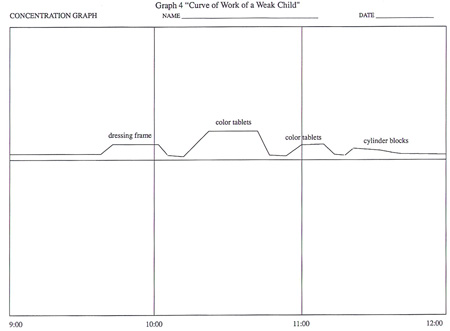 |
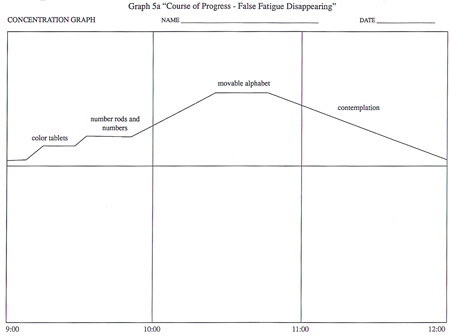 |
||
This child is not disrupting. He is beginning to focus and is on the way to what is called "normalization", or the ability to concentrate and be happy. However he is only working on activities for a short period of time, and many different activities in this 3-hour work cycle. |
This child enters the class and settles on work right away, reaching a high level of concentration. Notice that "contemplation" is clearly considered concentration. If a child is thinking, and not interrupting others, he should not be interrupted. | ||
Group Lessons? Concentration is an individual activity. |
Concentration: Valuable, spontaneous concentration occurs in many ways, but it does not include screen time. Montessori "work" is fun, the child's choice. Sometimes it is called "play" just because it is so enjoyable. It includes physical activity—of the whole body and the hands—work on real "practical life" activities, dance, art, music, and these skills combined with projects in academic subjects. Love: Providing for and supporting this deep need of the child is an act of love on the part of the parent, grandparent, or teacher. |
||
 |
|||
| Celebrating a Birthday by making A Personal Timeline: A good"Montessori" way to celebrate a birthday is to help a child create his own "personal timeline" near the end of their time in a Montessori primary class, usually at age 5 or 6. This is done as a quiet 1:1 activity, teacher and child, after gathering one picture for each year from the parents. The Red Corolla, Montessori Cosmic Education (for 3-6+) gives specific information on creating the personal timeline which is preparation for the the timelines that a child will encounter in the 6-12 class. For more information click on the link to The Red Corolla here: FIRST BOOKS Earlier birthdays that do not interrupt the morning work cycle, might be a simple birthday song at lunch and maybe sharing a treat from home, during a time when the children are already gathered, Or perhaps a special book, selected from the classroom list of "desired books for the class" with a bookplate giving the child's age. |
|||
CONCENTRATION QUOTES FROM MARIA MONTESSORI, MD |
|||
From Creative Development in the Child, The Montessori Approach, Volume II” (Page 207-208) From Creative Development in the Child, The Montessori Approach, Volume II” (Page 296) From The Child, Society and the World (Page 15) This is very difficult because the teacher has to interfere at every moment before the children are normalized. Generally teachers interfere when a child is working. They go to see what they are doing and praise them. This praise is an interference. The teacher goes to correct mistakes; this is an interference, even though it is an interference of good will. It is not interference to interfere when the child is naughty but this is just when Grown-ups often say, "Oh the child is so full of life", whereas when the child is working seriously they will often go and say "What are you doing? Show me". Then the concentration is broken; it finished. So never interfere when a child is working by himself. Don't be preoccupied about whether he is making mistakes, you must not correct him at this moment. The important thing is not that the child should handle the material, but that this material has attracted the attention of the child. The child corrects himself through repeating the exercise, through the control of error which is exact for some of the material. If you interfere, a child's interest finishes, the enchantment of correcting himself is broken. It is as though he says "I was with myself inside.You called me and so it is finished. Now this material has no more importance for me". A child does not need praise; praise breaks the enchantment. It is a great inner energy, normality, which comes, and you break this if you interfere. |
From Education and Peace (Page 80) From The Child in the Family (Page 32) |
||
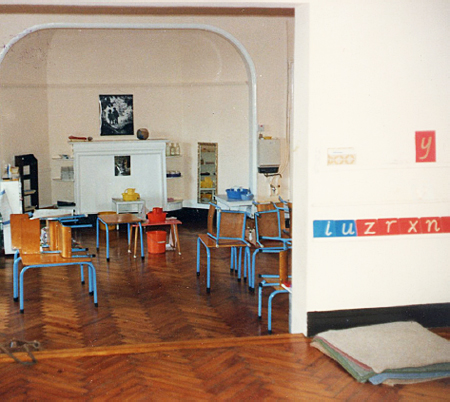 |
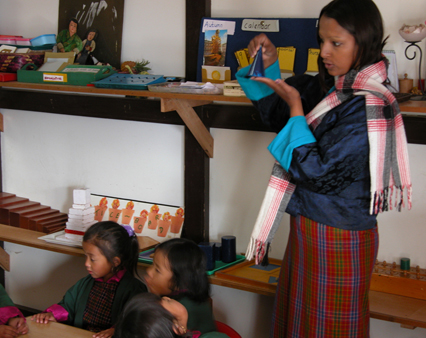 |
||
AN EXAMPLE OF A DAY IN A 3-6 CLASS WITHOUT GROUPS Even though there are no regularly scheduled group or collective lessons in authentic Montessori classes, groups are spontaneously formed in several ways including the beginning of a new class (where group lessons occur all day long as children learn to act independently, gradually the time between collective lessons increasing until the whole class is functioning independently), several new children joining a class at the same time, a teacher beginning to read to a child and a few others join in, a child gathers a few friends for a vocabulary game, occasionally a "going home" group as children await their parents, the 5 Great Lessons given in the beginning of a 6-12 class year, children in the 6-12 class group forming a group to plan a research project which often will be a group presentation to the rest of the class. But the interrupted 3-hour work period always takes precedence and no one is required to attend a group activity. This way of teaching requires a very high level of teacher training in order to know what child is ready for what lesson, and to be able to give that lesson without referring to a book or notes. In my AMI training this ability came partly from the hundreds of hours of practicals (practice giving lessons to fellow students and discussing the purpose, age, level of development, etc. for each one) under the supervision of the teacher trainer. The complete observation can be found in the book "Aid to Life, Montessori Beyond the Classroom: |
ALTERNATIVE USES OF MONTESSORI The 3-hour work period, deep concentration, normalization, the "miracles" —that amazed the world in the first Montessori Casa dei Bambini in Rome over 100 years ago, and occurs in many places today—will not occur in classes where the teacher is untrained or incompletely trained (taking a correspondence or short training course) or for some reason is not able to carry out what she learned in a full training course. But there can still be benefits. In the class pictured above the non-Montessori-trained teacher is using Montessori material, a geometric solid, to explain a concept to students in a traditional class in Bhutan
|
||
Newsletters announcing books #13 Book, Child of the World: Montessori, Global Education for Age 3-12+, March 2013 #23 Book, Montessori and Mindfulness, November 2017 #25 Book, The Red Corolla, Montessori Cosmic Education (preparation in the 3-6 class), June 2019 Other Newsletters of interest |
These books speak to anyone wanting to understand Montessori. They are based on the author's fifty years of experience as a Montessori teacher and administrator, speaker, school consultant, and examiner for Montessori teacher training courses. Some have been translated in other languages, the English versions are available from Montessori book suppliers and online. QUOTING BOOKS AUTHOR'S WEBSITE, Montessori work over the years, art and international blog, SUSAN MICHAEL OLAF Montessori information MICHAEL OLAF MICHAEL OLAF Montessori shop BOOKS & MATERIAL
This page was updated on May 10, 2022 |
||
